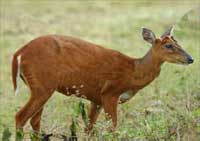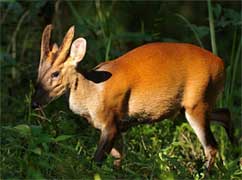Muntjac
Introduction
Page 1 of 5
The Indian Muntjac or Barking deer or Red Muntjac with the scientific name
Muntiacus muntjak is the most widely seen muntjac deer species in the world and is one of the smallest among the deer family. Especially these are widely spread around Southern Asia.
The various other common names for this species are Southern Red Muntjac or Bornean Red Muntjac or Red Muntjac or Sundaland Red Muntjac. The Barking deer with the scientific name Muntiacus muntjak is one amongst the eleven sub species of the Muntjac family present around various parts of Asia.
It falls under the family Cervidae and species Muntiacus muntjak. The quick classification of Indian Muntjac is as below,
| Kingdom |
Animalia |
| Phylum |
Chordata |
| Class |
Mammalia |
| Order |
Artiodactyla |
| Family |
Cervidae |
| Genus |
Muntiacus |
| Species |
Muntiacus muntjak |
Physical Structure
The Indian Muntjac has a short, soft, thick and dense coat which is covered with grayish dark brown or yellowish-brown hair. The coat is golden color at the dorsal region and white colored at its ventral region. The tan color varies as the climate changes. The limbs are dark brown to reddish brown color and the face is usually colored brown.
They have a long nose compared to other deers. They have a small head with short ears which are covered with short hair. Males possess antlers which are short and have only one branch. Females possess tufts of fur and small bony knobs instead of antlers. Munjtac have a upper canine which seems to slightly curve outward from the lips.
Page 2 of 5
Males are larger than females. The average body length varies from 35 to 53 inches wide and 15 to 26 inches tall.
They weigh about 16 to 34 kilograms. The antlers grow upto 15 cm in length with a single branch. The male tusks can reach upto 1 inch. Their maximum life span is 20 to 30 years. The alarm call of a Barking deer is taken seriously only when it repeats endlessly.
Subspecies of Indian Munjtac
The fifteen subspecies of Barking deer are known to exist around the world, and they are given in the below table:
| Subspecies name |
Distributed areas |
| M. m. annamensis |
Indochina |
| M. m. aureus |
Peninsular India |
| M. m. bancanus |
Billiton , Banka Islands |
| M. m. curvostylis |
Thailand |
| M. m. grandicornis(Burmese Muntjac) |
Burma |
| M. m. malabaricus |
South India , Sri Lanka |
| M. m. montanus(Mountain Muntjac) |
Sumatra |
| M. m. muntjak (Javan Muntjac) |
Java , south Sumatra |
| M. m. nainggolani |
Bali , Lombok Islands |
| M. m. nigripes( Black-footed or Black-legged Muntjac) |
Vietnam , Hainan Island |
| M. m. peninsulae |
Malaysia |
| M. m. pleicharicus |
South Borneo |
| M. m. robinsoni |
Bintan Island , Linga Archipelago |
| M. m. rubidus |
North Borneo |
| M. m. vaginalis |
Burma to southwest China |
Behaviour
Page 3 of 5
Barking deer are solitary animals except for the young ones which are
found with their mother and the adults during the rutting season. They usually make a dog-like barking sound in order to alarm when in danger. They increase or repeat the call for long hours when they are threatened by any other animals. Barking deer exhibit both diurnality and nocturnality.
Distribution and Habitat
Indian Muntjac can be found in various places of the Indian Subcontinent majorly in the North eastern parts of India. Other than India they are found in various other countries like Bangladesh, Nepal, Sri Lanka,Pakistan, Southern China, Vietnam, Bali, the Malay Peninsula, Sumatra, Riau Archipelago, Bangka, Java, Belitung Islands, Borneo and Cambodia. They prefer various habitats like,
• Subtropical/Tropical Dry forest
• Subtropical/Tropical Moist Lowland forest
• Subtropical/Tropical Moist Montane forest
• Savanna
• Tropical deciduous forest
• Tropical scrub forest
• Subtropical/Tropical Seasonally Wet/Flooded Grasslands
• Artificial/Terrestrial - Rural Gardens
• Artificial/Terrestrial - Arable Land
• Artificial/Terrestrial - Plantations
• Artificial/Terrestrial - Pastureland
• Artificial/Terrestrial - Subtropical/Tropical Heavily Degraded Former Forest
Places found
Page 4 of 5
The various places where Barking deer are found in India are:
• Kaziranga National Park
• Pench National Park
• Jim Corbett National Park
• Bandhavgarh National Park
• Bandipur national park
• Manas National Park
• Mudumalai National Park
• Bhadra Wildlife sanctuary
Food habits
Barking deer is an omnivorous species and their food habits vary depending on their habitat. They are both good browsers and grazers. Their diet consists of grasses, low growing leaves, branches, barks, prickly bushes, ivy, herbs, fruits, sprouts, tender shoots, seeds, bird eggs, fruits, fungi, carrion, and young blooded animals. They use their feet to stamp prey to death and use their tusks to tear the prey.
Mating behavior
The mating season happens throughout the year and no specific duration has been noted. They acquire territories where they leave scent markings on ground and trees. These markings help them to find whether the territory is occupied or not. The male deer guard their territories and attract their pair through vocal and olfactory means. They became sexually mature during the age of one to two years. The gestation period is 6 to 7 months and litters one offspring at a time in the midst of a dense growth. At rare occasion it delivers twins. The calf weighs one kilogram and is weaned for 2 to 3 months and stay with their mother till 2 year of age.
Page 5 of 5
Threats to Indian Barking Deer:
The major threat encountered by Barking deer is hunting wherein they are beeing
hunted for their meat and fall as a prey for their predators such as Leopard, lion, tiger, etc.
Other threats includes Residential & commercial development, Housing & urban areas, Agriculture & aquaculture, Annual & perennial non-timber crops, Agro-industry farming, Wood & pulp plantations, Agro-industry plantations, Energy production & mining, Mining & quarrying, Transportation & service corridors, Roads & railroads, Biological resource use, Hunting & trapping terrestrial animals, Intentional use (species is the target), Logging & wood harvesting and Motivation Unknown/Unrecorded.
Population of Indian Muntjac in India
In India, large population of barking deer can be found in well-secured protected areas and its population is unknown. International Union for Conservation of Nature and Natural Resources (IUCN) has categorized Indian Munjtac as 'Least concern' species and their population is found to be stable.
Interesting Facts
• They are addressed as "Barking deer" because of the deep bark like sound
• The tusk is used as defense weapons and causes serious injury.
• Munjtac are very primitive in the deer family.




